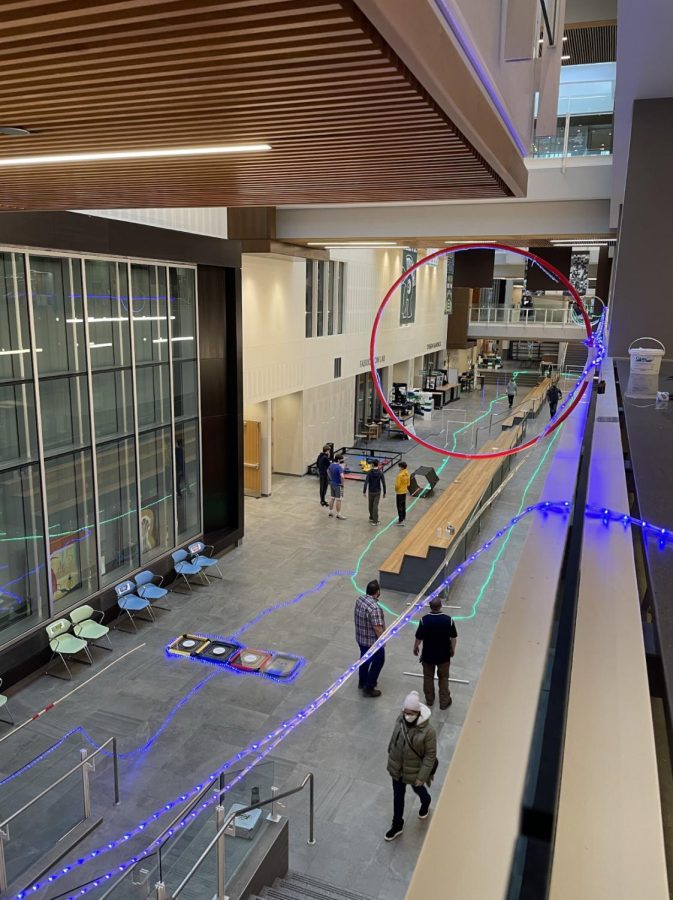May the best drones win
Drone Racing has picked since pre-COVID times, defying the air once again
Andrew Ahn
New Trier arranged their lit up obstacles in the concourse area for their first drone race of the season on Jan. 22
Lights span across the walls in elliptical loops. Birds of steel whiz by too fast for the naked eye. Drones are the future, and they start right here in Robotics Club.
Drone Racing is one of the Robotics Club four sectors, along with Underwater, Prosthetics, and Land-based Robotics.
In Drone Racing, members race drones against schools around the area. Senior Jon Mensah explained that races at New Trier take place at the concourse area, and racers build and set up these obstacles called “gates” for drones to fly though.
“What we do is we create courses to go against other high schools and middle schools, and with our varsity and JV teams, we race smaller drones around the New Trier concourse area, and see who gets first place. It’s really like a sport. We just build, fly, and repeat,” said Mensah.
Robotics Club operates under a budget, so they get grants by applying for a Student Alliance to sustain the club. They purchase their drones through the New Trier Educational Foundation, and adjust the speed of these drones as needed.
Competitions are hosted by GoDroneX, an Illinois-based organization that facilitates drone races and provides schools with the equipment and tools for drone clubs. These races take place in different schools around the area.
The races themselves have two events: the main event which counts for the school’s overall score, and an individual event where members race drones to set personal records.
In the main event there are four teams flying at once. Each team has two members. Senior Nikita Dubrovskyi explained that each team has a total of eight minutes to complete as many laps with their drones.
“Because we can only have about four people flying at once until we start getting video interference, we have to split all the teams up into heats. Each heat is one race, so there will be five rounds in each race,” said Dubrovskyi.
Out of the five rounds, the judges will only score the three highest scoring rounds. As a result, each team can discard their two slowest rounds.
The races are too long for just one person to fly because the drones are on a battery. So, one partner must make as many laps as they can before landing, changing the battery, and letting their partner take off. Member of the applied arts faculty, and sponsor of Robotics Club, Chip Finck, said it’s important for every member to get a chance to fly.
“We have this 40% rule so that you don’t have the person who’s the best pilot flying the whole time. So the lowest laps any person can make has to be 40% of the total. Otherwise it’s a huge penalty, and they get deducted laps as a result,” said Finck.
Each lap is worth one point, so the points of each race from the main event are totalled up on a whiteboard to determine the rankings of each school.
Afterwards, competitions host a final event with individual timed races. Every racer gets a chance to do a complete lap around the obstacle course to keep track of their best times. The racers with the fastest times in this event used to get drones awarded to them by Horizon Hobby, a big RC store.
“Before Covid, the organizer of GoDroneX managed to get a sponsorship from Horizon Hobby. But I don’t think he has that partnership this year, so I don’t think there’s any awards this year,” said Dubrovskyi.
During pre-Covid races, there was a third event where competitors would design gates. The most interesting gate would be awarded a prize. Competitions no longer have these events this year, but competitors continue to create innovative designs for gates.
Senior Andrew Ahn said the gates have to be four square feet, and members can make shapes for drones to fly through. They have to buy LEDs for it because the camera on the drone is not the greatest quality.
“Some of our gates can have motors attached to them so they spin, or a whole tunnel that you can go through. This year we put mirrors inside one of our tunnel gates, so it looks like a kaleidoscope. We’ve been getting a lot more creative with our gates, and I’m really proud,” said Ahn.
Last year, there were no races held for drones since schools went remote. Even though members couldn’t race, however, they were able to spend time upgrading their drones.
“The drones used by New Trier today use a more powerful and efficient type of motor compared to the older drones I saw stored in the group’s cabinet,” said freshman Eric Arrowsmith.
On Jan. 22, the first drone race of the season was hosted at New Trier. New Trier had two varsity teams and one JV team competing. Huntley High School brought one high school team, and Deerfield brought in a total of 6 teams with junior high and high school teams.
Aside from New Trier, there were no other varsity teams, so the competition was mainly for JV. New Trier’s JV team managed to place first.
“It was also JV’s first experience in drone racing. So I’m really proud of them and I’m proud that they flew well,” said Mensah.
First time drone racers tend to experience their fair share of crashes, but JV managed to hold their own during their first time racing this year.
“I was pretty impressed with them. I remember my first race, and I was in JV, and I was always crashing into things. I was all over the place, breaking drones, but seeing them racing, they were super calm. They were actually getting a lot of laps, and that was really cool to see,” said Ahn.
Senior Angelica She said that if a drone does end up crashing, it’s the pilot’s responsibility to repair it themselves if the damage doesn’t require them to purchase a whole new drone.
“The people who have just joined don’t know much about the actual building of gates, and basically only know how to fly,” said She. “But for the future, they’re going to have to learn everything else as well, including how to fix their drones.”
Drone racing is a field that’s bound to advance into something extraordinary in the future, so learning how they work in every aspect is a huge step in the right direction.
“Drones are the future of the world. On TV, for instance, there’s DRL, which stands for Drone Racing League. They race these huge drones, and they are planning to make man-driven drones where there is a person racing inside a drone,” said Mensah. “So that’s the future, and it starts all the way here with these tiny drones.”









































